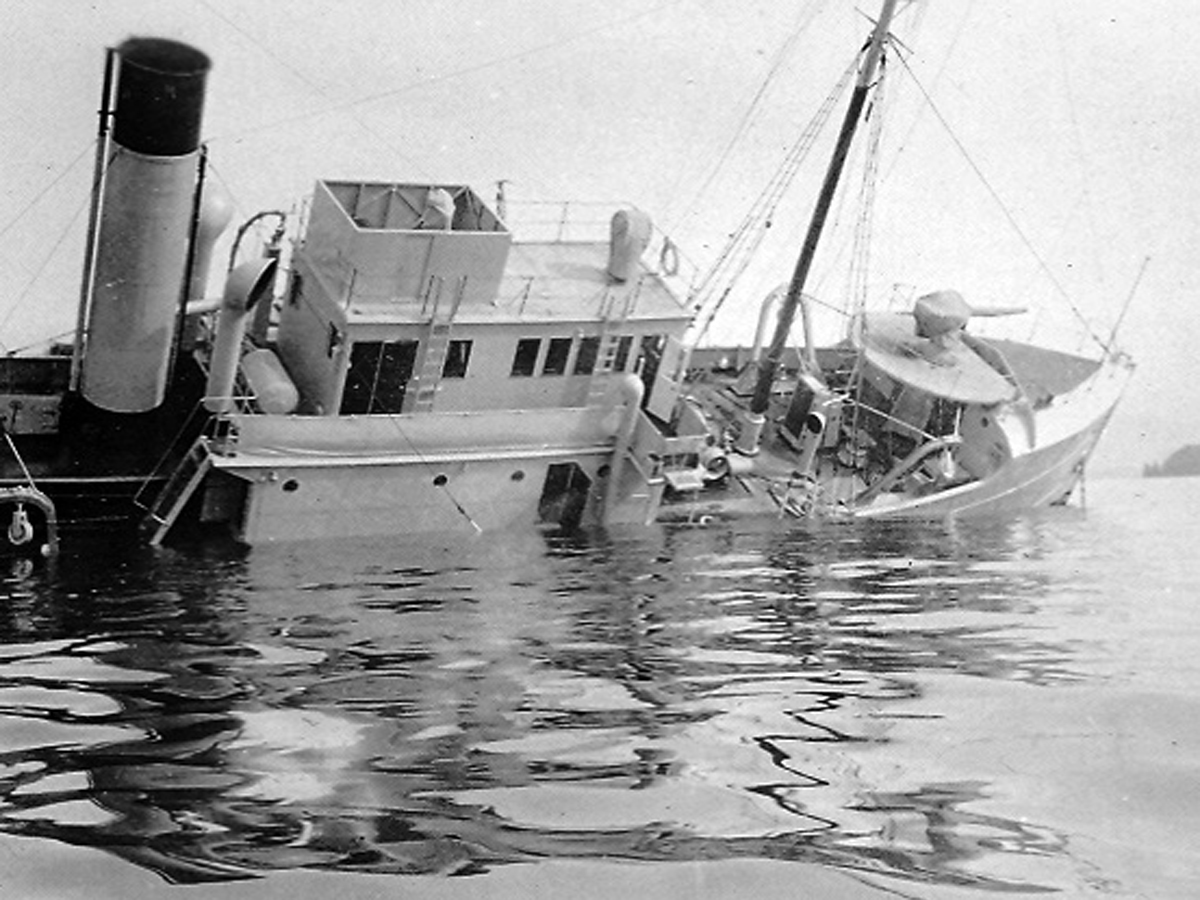The remarkable journey of HMCS Thiepval
By Lookout Production on Feb 09, 2023 with Comments 0
Clare Sharpe, CFB Esquimalt Naval & Military Museum — HMCS Thiepval, a steadfast trawler that once travelled 10,000 miles in search of old-fashioned adventure as a support vessel for an epic round-the-world flight attempt, is now a shipwreck of national historical significance and a trendy site for recreational divers.
Thiepval was launched in Montreal, Que., in 1917 and named for the First World War battle of Thiepval Ridge, in which many Canadian troops fought and died. It was designed initially as a fishery patrol vessel for the Dominion Government of Canada but was later modified as a minesweeper before its first commission in the RCN. During its short wartime career, the ship guarded convoys and hunted for U-boats off Newfoundland in response to the increasing threat to merchant ships in the Atlantic from German submarine activity.
In peacetime, Thiepval was transferred to Esquimalt, and served as part of RCN life-saving winter patrols along the treacherous west coast of Vancouver Island, the so-called ‘graveyard of the Pacific’. Thiepval was damaged by rocks, once near Prince Rupert and later in Gunboat Passage near Bella Bella. On another occasion, it rescued its sister trawler, HMCS Armentieres, that was stuck on a rock in Barkley Sound.
Thiepval also took part in northern patrols off Prince Rupert and worked as a fishery inspection vessel, sometimes stopping and seizing American fishing boats that had ventured too far into Canadian waters. Another duty was to intercept American rum runners engaged in smuggling alcohol to U.S. markets. In 1921, Thiepval used one of its shipboard guns to fire a warning shot across the bow of the Sylph, a fast U.S. boat that took off after being caught loading liquor from a Canadian supplier while just south of the border with Alaska.
Thiepval’s most incredible seagoing adventure came in 1924. As a support ship to a round-the-world flight bid by Squadron Leader Archibald Stuart-MacLaren, it battled rough seas and weather and desperate shortages of fuel, food, and water. When Stuart-MacLaren arrived in Russia’s Kamchatka Peninsula on July 24, 1924, Thiepval was waiting at Petropavlosk with vital fuel and spare parts. It had set off from Vancouver Island with 3,100 gallons of aviation fuel in jerry cans and loaded with extra water, coal and other necessary supplies. It was also tasked with a secret intelligence gathering assignment from the Canadian government – to determine if American and Japanese territories in the North Pacific were being fortified in contravention of naval treaties. It turned out they weren’t.
Through the dense fog, terrible snowstorms and rough seas, the ship had made its way along the Alaska coast to the Aleutian Islands, crossed the Bering Sea and made landfall in Russia’s far east. In the process, Thiepval became the first Canadian warship ever to visit Russia.
From Petropavlovsk and its rendezvous with Stuart-MacLaren, Thiepval sailed on to Hakodate on the island of Hokkaido in northern Japan and another historic first: the first Canadian warship to visit Japan. The stopover was a welcome rest for the little grey minesweeper’s exhausted crew. When Thiepval dropped anchor in Hakodate harbour, there wasn’t a drop of fresh water aboard and only enough coal in the bunkers for another hour of steam-powered travel, at best. While resupplying their ship with water, fuel and food after running dangerously low, the ship’s company enjoyed a warm welcome from officials, played football with residents and enjoyed the countryside. At the same time, they waited for news of Stuart-MacLaren’s expedition. They also acquired a couple of unusual souvenirs, a pair of higumas (brown bears) from the northern island. (One of these bears, nicknamed ‘Bruno’ – or sometimes ‘Haca-Daddy’, a version of Hokadate – returned to Esquimalt with them and became a renowned resident of what is now known as the Museum Square at Naden).
Unfortunately, the bid by Stuart-MacLaren to break aviation records failed miserably when his plane was forced to make an emergency landing in the open sea, and a wave smashed a wing tip float of the Viking Vulture amphibian aircraft EBHO. Soon the other float suffered a similar fate, and the aircraft started to break up, ending its epic journey on a desolate Kamchatka beach. It was a sad end to a heroic effort, and those aboard Thiepval were just as downhearted.
Thiepval steamed through the night to reach the crippled plane and hauled its wreckage aboard, sending the bitter news of the flight’s failure by wireless message to The Times of London before heading home to Canada’s Pacific coast, where it arrived to a very subdued reception at Vancouver, on
Aug. 20, 1924. Then it was on to Esquimalt, where the Senior Naval Officer saluted the ship’s Commander, W.R.J. Beech, with a hearty British welcome, “Well played, Sir!” The ship and her company soon returned to their routine duties policing the fishery and attempting to thwart smugglers and search and rescue duties along the coast.
On Feb. 27, 1930, HMCS Thiepval ran aground in the Broken Group Islands of Barkley Sound, B.C. Its seagoing career ended on February 29, 1930, after the ship was ordered out on a life-saving patrol off Bamfield. In the Broken Group islands, there was a sudden shivering crash. For the third, and this time final, occasion in its history, Thiepval hit an uncharted rock. The ship company was forced to abandon the vessel, which eventually slipped from its rocky ledge and sank. The memory of Thiepval then disappeared for many years until the growing popularity of recreational scuba diving provided a new role as a wreck for exploration.
Now it is inside the boundaries of Pacific Rim National Park, lying at the bottom of the channel that now bears its name.
Filed Under: Top Stories
About the Author:






